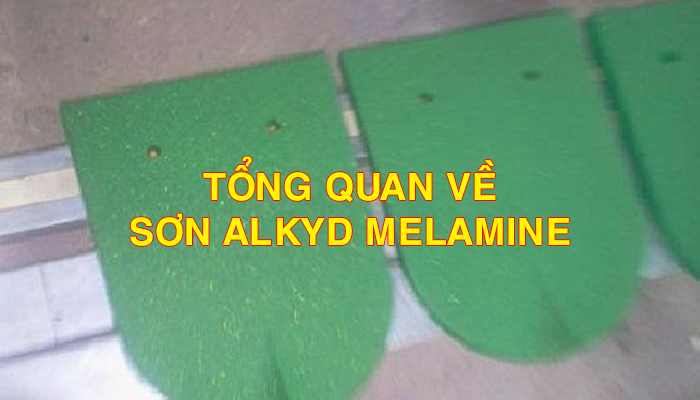TỔNG QUAN VỀ SƠN ALKYD MELAMINE
1. Giới thiệu
Sơn alkyd melamin là hệ sơn trên cơ sở sự phối trộn giữa hai loại chất tạo màng là nhựa melamin formaldehyde và nhựa alkyd. Sơn alkyd melamin là loại sơn khô hóa học, sau khi được gia công màng sơn sẽ khô khi có tác động của nhiệt độ (110°C- 130°C) hoặc xúc tác axit yếu.
Ngoài nhựa alkyd, các loại nhựa khác như nhựa acrylic, epoxy…có thể phối trộn với nhựa melamin formaldehyde để làm sơn khô sấy. Một loại chất tạo màng khác tương tự nhưa nhựa melamin formaldehyde là nhựa urea formaldehyde cũng hay được dùng để phối trộn với nhựa alkyd, acrylic…để làm sơn khô sấy hoặc khô xúc tác axit. Hai loại chất tạo màng melamin và urea formaldehyde được gọi chung là nhựa amino.
Tùy theo loại nhựa phối trộn để làm sơn mà có các loại sơn khác nhau:
- Sơn Alkyd Melamin: phối trộn nhựa melamin formaldehyde với nhựa alkyd
- Sơn Acrylic Melamin: phối trộn nhựa melamin với nhựa acrylic nhiệt rắn
- Sơn Epoxy melamin: phối trộn nhựa melamin với nhựa epoxy
- Sơn Alkyd urea: phối trộn nhựa ureaformaldehyde với nhựa alkyd, loại này có thể đóng rắn bằng nhiệt độ hoặc bằng axit yếu.
- Sơn hỗn hợp: phối trộn nhựa melemin/urea với hơn một loại nhựa alkyd, epoxy, alkyd...
Nếu phân loại theo quá trình khô ta có hai loại:
- Sơn khô sấy
- Sơn khô axit (thường hay dùng nhựa urea
 Ảnh: Minh họa
Ảnh: Minh họa
>> Xem ngay các loại hóa chất ngành sơn tốt nhất hiện nay trên thị trường <<< />pan>
2. Nguyên liệu chất tạo màng sản xuất sơn alkyd melamin
2.1. Một số tính năng Nhựa melamin formaldehyde
- Khô nhanh.
- Bền kiềm và xà phòng.
- Sự chịu đựng tốt,nếu chẳng may bị sấy quá nhiệt
- Màng sơn khó nhăn hơn,do đó có thể gia công màng dầy.
- Độ bóng ban đầu và tính chảy tốt.
- Hàm lượng nhựa amino trên tổng hàm rắn nhựa thấp.
- Bền thời tiết (tốt nhất trong các loại amin formaldehyde).
- Màng sơn cứng hơn.
- Sơn Melamin với bản chất bền nhiệt và bền thời tiết nổi bật thì thích hợp với lớp sơn phủ và đặc biệt thích hợp với việc dùng trong sơn nhiều lớp
2.2. Chất tạo màng phối trộn với melamin
Các loại chất tạo màng hay được dùng để phối trộn với melamin phổ biến nhất là nhựa alkyd, bên cạnh đó acrylic cũng hay được dùng, ngoài ra còn có epoxi, alkyd styrene, polyester…Và mỗi sự phối trộn sẽ cho ta một loại sơn với các tính năng khác nhau. Trong bài viết này, chúng tôi chỉ đề cập đến nhựa Alkyd.
a. Nhựa Alkyd
Nhựa alkyd là chất tạo màng có được qua quá trình đa tụ của một axit đa chức hoặc các anhydric của chúng như: phthalic anhydride, isophthalic…với một rượu đa chức như pentaerythritol, tri-methylolpropane…Tuy nhiên nhựa alkyd chỉ đi từ rượu và axit không dùng để làm sơn được vì một số bất lợi như: độ tan thấp, khó tương hợp…Để có thể làm sơn ta phải biến tính nó với dầu (dầu thảo mộc, dầu động vật) hoặc axit béo có nguồn gốc dầu mỏ. Bên cạnh các axit đa chức và rượu đa chức dùng để sản xuất nhựa alkyd, bản chất của dầu và hàm lượng dầu biến tính cũng có ảnh hưởng mạnh đến tính năng của nhựa và màng sơn cuối cùng. Hàm lượng dầu tính theo khối lượng dầu trong nhựa được gọi là độ béo của nhựa alkyd. Dựa vào độ béo (hàm lượng dầu) mà người ta chia nhựa alkyd làm các loại:
- Alkyd gầy.
- Alkyd trung bình.
- Alkyd béo.
Theo sự tăng hàm lượng dầu trong nhựa alkyd các tính năng như: hàm rắn, độ tan, dễ gia công, mềm dẻo, bền nước, bền lưu kho cũng tăng theo. Trong khi đó các tính năng như: độ nhớt, độ bóng, độ cứng, bền dầu, bền mầu lại giảm theo sự tăng độ béo của nhựa. Độ khô và độ bám dính của nhựa alkyd sẽ tối ưu khi hàm lượng dầu khoảng 50-55%, còn độ bền thời tiết của nhựa alkyd tốt nhất khi độ béo là 65%.
Để tăng thêm một số tính năng đặc biệt cho nhựa alkyd, bên cạnh việc dùng dầu người ta còn có thể biến tính thêm với các nhựa khác:
- Biến tính với phenol: tăng tính bền nước và bền kiềm.
- Biến tính với nhựa thông
- Biến tính vinyl: cải tiến dộ bền thời tiết, độ cứng, bền nước và bền kiềm.
- Biến tính silicon
- Biến tính epoxy
- Biến tính acrylic
- Biến tính styrene
- Biến tính urethane
- Biến tính benzoic
>> Xem thêm: Công nghệ sản xuất sơn gỗ PU 2K trong nhà <<< />pan>
Có thể nói nhựa alkyd là được dùng rộng rãi nhất trong ngành sơn, nó có thể dùng trong sơn phủ nhiều loại bề mặt vật liệu như: kim loại, gỗ…sơn trong nhà, ngoài trời. Có thể dùng một mình hoặc trộn hợp với nhiều loại chất tạo màng khác như: amino, caosu clohóa, nitrocellulose, silicon.
Nhựa alkyd là chất tạo màng phổ biến nhất dược dùng để phối trộn với melamin (và các nhựa amino khác) để làm sơn sấy. Việc lựa chọn nhựa alkyd để phối trộn với melamin nói riêng và nhựa amino nói chung phải thỏa mãn các yếu tố sau:
- Phải tương hợp tốt với nhựa melamin (amino).
- Phải có chỉ số axit thấp để không xảy ra quá trình tự đóng rắn của sơn amino khô bằng nhiệt độ.
- Phải có đủ số nhóm chức hoạt động như nhóm hydroxyl.
- Trong nhiều trường hợp phải khá bền mầu.
Nhựa alkyd thích hợp nhất để phối trộn với nhựa amino là alkyd gầy. Cũng giống như nhựa amino các nguyên liệu đầu để sản xuất nhựa alkyd cũng có ảnh hưởng đến tính chất màng sơn và do đó nó ảnh hưởng đến việc lựa chọn trong từng lĩnh vực cụ thể.
b. Một số chất tạo màng phối trộn khác
Ngoài alkyd người ta còn hay dùng nhựa acrylic, epoxy. Những chất tạo màng này có thể dùng một mình hay phối hợp với nhau hoặc với nhựa alkyd để được màng sơn có một số tính năng tốt hơn. Đối với nhựa acrylic để phối trộn với amino phải dùng nhựa nhiệt rắn có chỉ số hydroxyl hợp lý. Còn nhựa epoxy thì phải có phân tử lượng không quá lớn để có khả năng tương hợp với amino khác
Trên đây là một số giới thiệu sơ bộ về nguyên liệu sơn Alkyd Melamine. Để có thông tin chi tiết hơn vui lòng liên hệ chúng tôi.
>> Nhận tư vấn chuyển giao công nghệ sản xuất sơn Alkyd <<< />pan>
Mọi thông tin vui lòng liên hệ:
Ban Biên tập Mega Việt Nam
Địa chỉ: Tầng 2-A2-IA20, KĐT Nam Thăng Long, đường Phạm Văn Đồng,
P. Đông Ngạc, Q. Bắc Từ Liêm, TP. Hà Nội, Việt Nam.
Email: contact@megavietnam.vn
Tel: (+84) 24 375 89089; Fax: (+84) 24 375 89098
Website: megavietnam.vn
Hotline: 1800.577.728; Zalo: 0971.023.523








